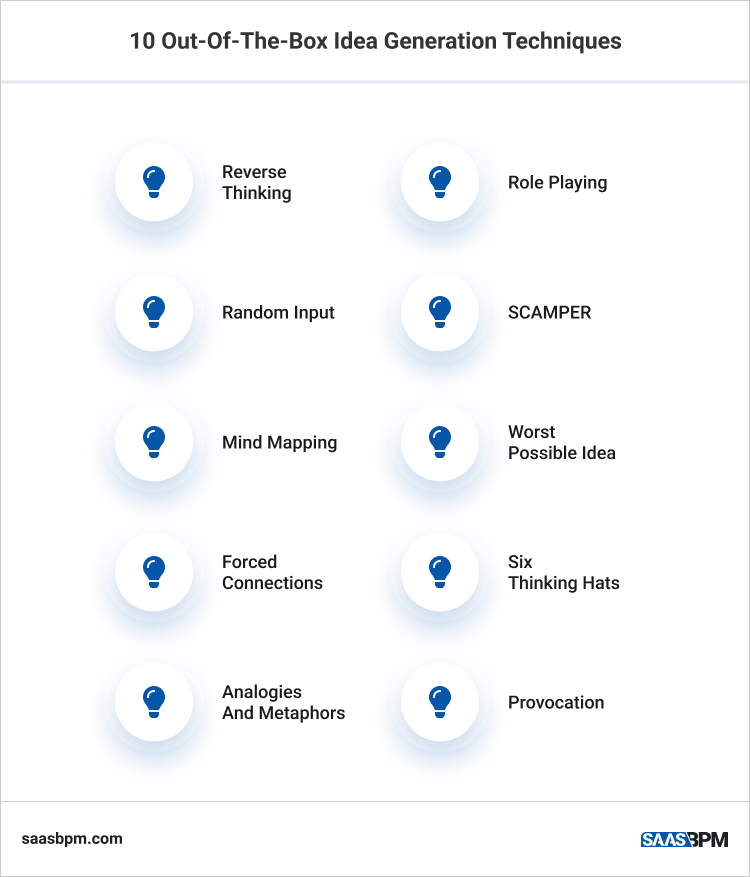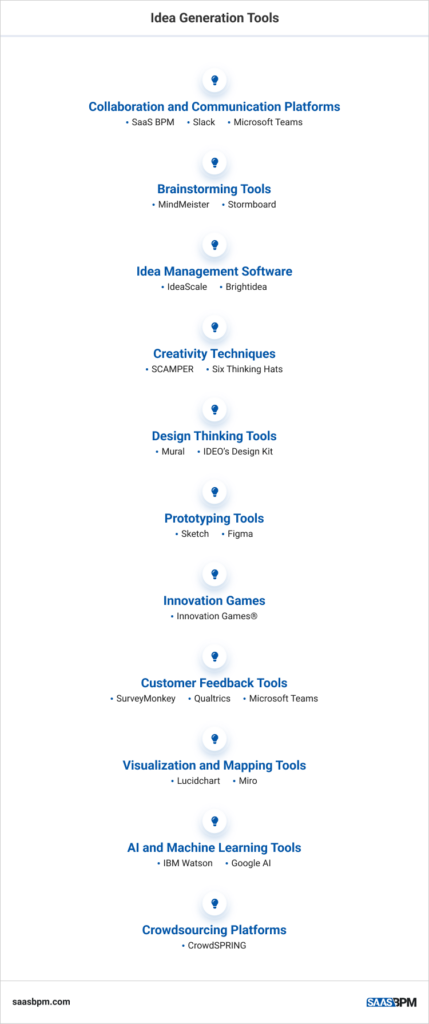Ideas are the foundation of innovation. Without them, there’s nothing to implement, and since execution is crucial for learning, fresh ideas are essential for any kind of progress. Just like a spark without fuel, an idea without a structured process is just a flicker of light in the dark. This is where idea generation comes into play.
Your business needs a framework that nurtures these sparks into full-fledged flames of innovation. Brainstorming sessions are great, but it’s not just about the quantity of ideas you generate—it’s about quality and focus.
Although it’s easy to fall into routines and habits, we need to break free to think outside the box and find original solutions that work. In this article, we will explain what idea generation entails, point you to tools to use and outline helpful methods to implement the process in your company.
Without further ado, let’s dive into the world of productive and creative business ideation!
What Is Idea Generation?

Idea generation, also known as ideation, is the creative process of developing new, innovative ideas. This process is fundamental to problem-solving, innovation, and progress within any organization or individual endeavor. It involves brainstorming, conceptualizing, and refining thoughts to create viable solutions or novel concepts.
At its core, idea generation is about exploring possibilities and thinking beyond the conventional boundaries. It encourages a free flow of thoughts without immediate judgment or criticism, fostering an environment where creativity can thrive. This openness is essential because it allows for the emergence of unique and unconventional ideas that might not surface in a more restrictive setting.
There are several methods to facilitate idea generation, ranging from individual techniques like mind mapping and free writing to collaborative approaches such as group brainstorming sessions and workshops. Tools like the SCAMPER method (Substitute, Combine, Adapt, Modify, Put to another use, Eliminate, and Reverse) or the Six Thinking Hats technique by Edward de Bono are commonly used to stimulate creative thinking.
Idea generation is not just about quantity but also about quality. The objective is to produce a diverse array of ideas and then identify and refine the most promising ones. This iterative process often involves several stages: initial brainstorming, idea selection, development, and testing. Each stage is crucial to ensure that the final ideas are both innovative and feasible.
In today’s fast-paced, competitive environment, effective idea generation can give businesses and individuals a significant edge. It can lead to breakthroughs in products, services, processes, and strategies, ultimately driving growth and success. By fostering a culture that values creativity and open-mindedness, organizations can continuously innovate and stay ahead of the curve.
10 Out-Of-The-Box Idea Generation Techniques

Generating innovative ideas requires stepping outside your comfort zone. To effectively use the out-of-the-box techniques we’ve listed below, create an open and supportive environment where all ideas are valued.
Reverse Thinking
Reverse thinking involves flipping the problem to think about how to achieve the opposite of the desired outcome. For example, instead of asking, “How can we increase sales?” ask, “How can we decrease sales?” By exploring these negative outcomes, you can uncover hidden issues and new approaches that can be applied constructively.
Role Playing
In role playing, participants assume the identities of different personas or stakeholders related to the problem. By stepping into someone else’s shoes, individuals can gain new insights and perspectives. For example, role-playing as a customer can help identify unmet needs and areas for improvement in a product or service.
Random Input
This technique involves introducing random, unrelated stimuli to the brainstorming process. Pick a random word from a book, a random object from the room, or a random image from the internet. Use this input to inspire new ideas and connections that might not have been considered otherwise.
SCAMPER
This technique encourages looking at a problem or idea through these seven different lenses to uncover innovative solutions. For example, consider how you can modify an existing product to better meet customer needs or how you can combine features from two products to create a new offering.
Mind Mapping
Mind mapping involves visually organizing information around a central concept. Start with the main idea in the center and branch out with related ideas, concepts, and solutions. This technique helps structure thoughts and identify relationships between different elements, often leading to new insights and ideas.
Worst Possible Idea
Encouraging participants to come up with the worst possible ideas can lower inhibitions and stimulate creative thinking. Once you have a list of terrible ideas, analyze them to see if there are any elements that can be transformed into good ideas or if they highlight areas that need addressing.
Forced Connections
Forced connections involve pairing unrelated concepts or objects to spark new ideas. For example, randomly select two words from a list and think about how they could be connected or combined to solve a problem. This technique can lead to unexpected and innovative solutions by breaking down traditional thinking patterns.
Six Thinking Hats
Developed by Edward de Bono, this method involves looking at a problem from six different perspectives: facts (white hat), emotions (red hat), critical judgment (black hat), positive judgment (yellow hat), creativity (green hat), and process (blue hat). By systematically addressing each perspective, this technique ensures a thorough exploration of the problem and potential solutions.
Analogies and Metaphors
Using analogies and metaphors can help reframe a problem and stimulate creative thinking. Think about how similar issues are solved in different fields or contexts and apply those solutions to your problem. For example, consider how nature solves a particular challenge and see if that solution can be adapted to your situation.
Provocation
Provocation involves making provocative statements or assumptions to challenge the status quo. These statements do not need to be practical or logical but are intended to push boundaries and encourage creative thinking. For example, imagine a world where resources are unlimited and think about how that would change your approach to problem-solving.
What Are the Tools for Ideation?
Idea generation requires tools and techniques to facilitate creative thinking and collaboration. Various software can help individuals and teams generate, refine, and implement new ideas effectively. Here are some of the most popular and effective tools for ideation:

1. Collaboration and Communication Platforms
Effective ideation often requires seamless collaboration:
SaaS BPM. Our business process management tool helps teams stay connected across tasks and projects. Relevant communication on each task is kept transparent and organized within the respective project.
Slack. A messaging platform that supports real-time communication and collaboration. It integrates with other tools like Google Drive and Trello, making it easier for teams to share ideas and feedback.
Microsoft Teams. Combines chat, video meetings, file storage, and application integration. It’s a comprehensive platform for team collaboration, especially useful for brainstorming sessions and project discussions.
2. Brainstorming Tools
Brainstorming is one of the most common ideation techniques, and several tools can enhance its effectiveness:
MindMeister. This online mind mapping tool allows users to visually organize their ideas. It’s particularly useful for brainstorming sessions as it lets teams create, share, and collaborate on mind maps in real-time.
Stormboard. A digital whiteboard that combines sticky notes and collaboration features. Teams can brainstorm, organize, and prioritize ideas seamlessly, making it easier to move from ideation to action.
3. Idea Management Software
Idea management software helps organizations capture, evaluate, and implement ideas systematically:
IdeaScale. This platform enables companies to collect ideas from employees, customers, and partners. Ideas can be voted on and discussed, helping organizations identify the most promising ones.
Brightidea. A comprehensive innovation management suite that provides tools for idea collection, evaluation, and project management. It helps ensure that good ideas don’t get lost and can be developed into actionable projects.
4. Creativity Techniques
Several tools use structured creativity techniques to stimulate idea generation:
SCAMPER. This tool prompts users to think about their ideas or problems in seven different ways (Substitute, Combine, Adapt, Modify, Put to another use, Eliminate, Reverse). It helps uncover new angles and innovative solutions.
Six Thinking Hats. Developed by Edward de Bono, this method encourages group members to look at problems from six different perspectives (information, emotions, critical judgment, positive judgment, creativity, and process). It can help generate more balanced and comprehensive ideas.
5. Design Thinking Tools
Design thinking emphasizes understanding users and their needs to generate innovative solutions:
Mural. A digital workspace for visual collaboration that supports design thinking activities like empathy mapping, journey mapping, and brainstorming. It’s great for remote teams.
IDEO’s Design Kit. Offers a variety of tools and resources for practicing design thinking, including guides for conducting interviews, prototyping, and storytelling.
6. Prototyping Tools
Prototyping tools help turn abstract ideas into tangible concepts that can be tested and refined:
Sketch. A digital design toolkit used for creating user interfaces and prototypes. It allows designers to visualize ideas and iterate quickly.
Figma. A cloud-based design tool that enables real-time collaboration on prototypes. It’s particularly useful for teams working on UX/UI design.
7. Innovation Games
Gamification can stimulate creative thinking and problem-solving:
Innovation Games®. These are serious games designed to help teams generate ideas and solve problems. Examples include “Product Box” (where teams create a product’s packaging to clarify its value) and “Buy a Feature” (where stakeholders prioritize features by spending a limited budget).
8. Customer Feedback Tools
Understanding customer needs and preferences is crucial for generating relevant ideas:
SurveyMonkey. An online survey tool that helps collect feedback from customers. This feedback can be invaluable for generating new ideas and improving existing products or services.
Qualtrics. A robust platform for conducting surveys, analyzing data, and gaining insights into customer preferences and behaviors.
9. Visualization and Mapping Tools
Visualization and mapping tools are essential for bringing abstract ideas to life:
Lucidchart. Allows teams to create flowcharts, diagrams, and mind maps to visualize and organize their ideas. It’s helpful for identifying connections and gaps in the ideation process.
Miro. A collaborative online whiteboard platform that lets teams create diagrams, mind maps, and other visual representations. It facilitates real-time collaboration and helps in structuring and refining ideas.
10. AI and Machine Learning Tools
AI and machine learning tools are increasingly important for enhancing ideation:
IBM Watson. Provides AI-driven insights and analytics that can help identify trends and generate new ideas based on large datasets.
Google AI. Offers various tools and frameworks for integrating AI and machine learning into the ideation process, helping to uncover innovative solutions and patterns.
11. Crowdsourcing Platforms
Crowdsourcing platforms leverage the power of the crowd to generate ideas:
CrowdSPRING. Allows businesses to tap into a community of creatives to generate ideas for branding, design, and marketing projects.
Bottom Line
Embracing out-of-the-box idea generation techniques is like giving your team a playground where they can let their creativity soar. Imagine reverse thinking as flipping the script and role-playing as stepping into different characters’ shoes. It’s like encouraging everyone to think like a child again, where every idea is explored with excitement and curiosity. By inviting playful exploration of even the craziest ideas, you’re fostering a culture where innovation thrives, and breakthrough solutions emerge from unexpected places.

